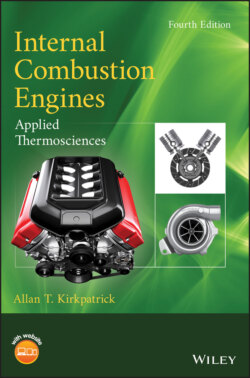Читать книгу Internal Combustion Engines - Allan T. Kirkpatrick - Страница 57
Intake Stroke
ОглавлениеThere is a flow of a gas mixture into or out of the cylinder during the intake stroke when the intake valve is opened, depending on the relative pressure difference. As indicated in Figure 2.10, there are three different flow situations for the intake stroke, depending on the ratio of inlet to exhaust pressure. If the inlet pressure is less than the exhaust pressure, the engine is throttled. In this case there is flow from the cylinder into the intake port when the intake valve opens. In the initial portion of the intake stroke, the induced gas is primarily composed of combustion products that have previously flowed into the intake port. In the latter portion of the stroke, the mixture flowing in is fresh charge, undiluted by any combustion products.
If the inlet pressure is greater than the exhaust pressure, the engine is said to be supercharged (turbocharging is a special case of supercharging in which a compressor driven by an exhaust turbine raises the pressure of atmospheric air delivered to an engine). In this case there is flow from the intake port into the engine until the pressure equilibrates. In actual engines, because of valve overlap, there may be a flow of fresh mixture from the inlet to the exhaust port, which can waste fuel and be a source of hydrocarbon exhaust emissions. The third case is when inlet and exhaust pressures are equal; the engine is then said to be unthrottled.
Since the intake gas temperature is usually less than the residual gas temperature, the cylinder gas temperature at the end of the intake stroke will be greater than the intake temperature. In addition, if heat transfer is neglected, the flow across the intake valve, either from the intake manifold to the cylinder or the reverse, is at constant enthalpy.
The unsteady open‐system mass and energy equations for a control volume, i.e., the increasing cylinder volume, are used to determine the state of the fuel air mixture and residual gas combination at state 1, the end of the intake stroke. The net gas flow into the cylinder control volume has mass , enthalpy , and pressure . Again, at this level of modeling, as the piston moves downward, it is assumed that the cylinder pressure remains constant at the inlet pressure, .
The initial state of the gas in the system at the beginning of the intake process is at state 6. For the overall process from state 6 to state 1 with the inlet flow at state , the open‐system conservation of mass equation is
(2.48)
The open‐system unsteady energy equation is
(2.49)
Integrating over the intake stroke from state 6 to state 1, where the work term accounts for the change in volume of the cylinder, and assuming ,
(2.50)
(2.51)
(2.52)
(2.53)
Therefore,
(2.54)
Rearranging, and if heat transfer during the intake stroke is neglected,
(2.55)
Since and ,
(2.56)
Solving for :
(2.57)
Therefore, the enthalpy at the end of the intake stroke is not just the average of the initial and intake enthalpies, as would be the case for a steady flow situation, but also includes the flow work term.
The equation for the enthalpy at the end of the intake stroke, Equation (2.57), can also be expressed in terms of the residual gas fraction, . From Equation (2.45),
(2.58)
so
(2.59)
and from the ideal gas law,
(2.60)
Upon substitution of Equations (2.58) and (2.60) into Eq. (2.57),
(2.61)
If the reference enthalpy is chosen so that , then
(2.62)
For example, if 0.05, 0.5, 1.35, 320 K, and 1400 K, then 365 K.
The volumetric efficiency of the inlet stroke for a gas cycle is given by
(2.63)
During the intake process, the gas within the control volume does work since the piston is expanding the cylinder volume. During exhaust, work is done on the gas. The net effect during the intake and exhaust strokes is
(2.64)
The negative of that work is called pumping work since it is a loss of useful work for the throttled engine. The pumping mean effective pressure is defined as the pumping work per unit displacement volume:
(2.65)
The indicated mean effective pressure (imep) is defined as the work per unit displacement volume done by the gas during the compression and expansion stroke. The work per unit displacement volume required to pump the working fluid into and out of the engine during the intake and exhaust strokes is termed the pumping mean effective pressure (pmep). It is the sum of the pressure drops across flow restrictions during the intake and exhaust strokes, including intake system, valves, and the exhaust system.
The following relations should be clear:
(2.66)
(2.67)
